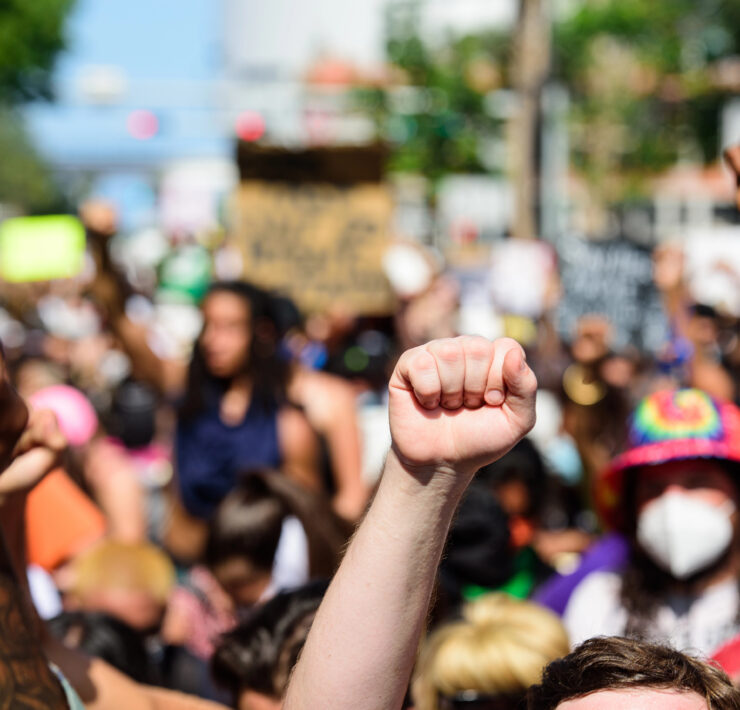LGBTQ+ Intimate Partner Abuse is So Heteronormative…
October is domestic violence awareness month. No one particularly likes to discuss this topic, for obvious reasons. The reality is, we need to get comfortable talking about it, especially queer people. For five years I worked exclusively in domestic violence, intimate partner abuse, assault prevention, and intervention. I worked with both those doing harm, those being harmed, and those in between. This domestic violence month, I want to support LGBTQ+ community members in identifying the systemic nature of violence and abuse in our relationships.
Culturally, we are very skilled at calling out and canceling people we don’t know for being abusive or doing harm. But when abuse and violence happen in our lives, relationships, families, and communities, when we actually can help, we look the other way. This needs to be viewed as a systemic issue, and the only way to change is through education and healing conversations. So, let’s start with the basics.
Let’s Start With the Basics
DOMESTIC VIOLENCE is traditionally associated with physical violence or aggressive behavior within a heterosexual home involving the violent abuse of a man directed at a woman. A more inclusive definition outlines Intimate Partner Violence and Domestic Violence as a pattern of power and control behaviors used in the context of dating and intimate relationships that can take place in any context, not just what is culturally considered a traditional home.
An intimate Partner is defined as one with whom you are in a close relationship that can be characterized by emotional connectedness, regular contact, ongoing physical and/or sexual contact, identifying as a “couple” or not, familiarity, and knowledge about each other’s lives. An intimate partner can be a traditional monogamous partner, a one-time anonymous sexual partner, a roommate, many partners, or even your best friend.
Conflicts are normal and healthy for all relationships when they are handled with assertiveness and active listening, the key being having a goal of mutual resolution. Healthy conflicts help clarify differences, create boundaries, and ideally create a deeper understanding of everyone involved. Unhealthy conflicts occur when the goal is to overpower or ‘win’ a fight. Consider this: In a relationship where conflicts are based on winning and losing, is there actually a winner if the one you love has to lose? What is the bigger-picture goal here?
Intimate Partner Abuse is Not Just Physical
A significant failure of our culture is believing that abuse and violence toward our partners is only physical. As a DV therapist, I have witnessed heinous acts of abuse that were never physical yet profoundly traumatized people. Often, close friends and family members never truly know what is going on. Most of the time, the people engaging in abuse don’t see it as abuse or simply refuse to see it as such. This is incredibly problematic! If a relationship negatively impacts the way you see yourself or degrades your self-esteem, there is potential abuse taking place; it doesn’t matter who the person is or how long you have known them.
Violence and Abusive Behaviors come in many forms, including:
Physical Violence: hitting, punching, slapping, blocking, spitting, shoving, driving recklessly, punching walls, throwing objects.
Sexual Violence: rape of a partner, forcing a partner to engage in sex, non-physically pressured contact, unwanted sexual contact, non-contact, unwanted sexual experiences, non-consensual intimate images taken or shared, guilting into sex with others, intentionally transmitting STI/D’s and HIV, non-consensual pregnancy.
Stalking: physical, verbal, electronic/ social media.
Psychological Aggression: outing gender identity, sexual orientation, sharing HIV status, sharing immigration status, emotional shaming, economic control, denying, minimizing, blaming, intimidation, threatening to harm self or pets or others.
Verbal: raising voices, name-calling, degrading, silent treatment.
Emotional: ignoring, minimizing, devaluing, placing responsibility of emotions on another.
Behaviors and Patterns
This list is by no means exhaustive. However, it illuminates how physical abuse is only a small fraction of harm that often occurs in relationships. In contemporary American culture, we accept incredibly harmful behaviors, but because they are not physical, they are not deemed abusive. If you find yourself engaging in any of the above-listed behaviors (receiving or exerting), I encourage you to engage in some real, honest self-reflection. What do you think are the intentions or motivations for those behaviors? I also invite you to ask yourself if those behaviors take on a pattern in your life or relationships. Do those behaviors feel cyclical or repeating?
THE CYCLE OF VIOLENCE
The Cycle of violence outlines a pattern often experienced in violent and abusive relationships. It is a continuous pattern described in three phases that transition or develop into each other. Over time, this pattern escalates and increases in severity further threatening the wellbeing and safety of those involved. The cycle is broken down into three phases: Tension Building, Explosion, and Remorse.
Tension Building: This is a period in a relationship where forms of violence and abuse are less pronounced or unnoticeable. Some minor physical, verbal, or emotional abuse may occur, but is less overt and swept under the rug. The person experiencing the abuse often attempts to prevent future violence by avoiding conflict, ignoring issues, and minimizing previous incidents. There is usually a sense of “walking on eggshells.” As tension builds over time, the likelihood of abuse also increases as the small incidents develop into larger feelings of resentment and imbalance, often called “case building.”
Explosion: An explosion describes an abusive incident(s) or period in a relationship. The water boils over. The bubble bursts. An abusive incident can involve many types of abuse, including verbal, psychological, emotional, financial, physical, sexual, and or stalking.
Remorse/Honeymoon: This occurs following the explosive phase when an abuser feels remorse and guilt for their behavior. They apologize, promise never to abuse again, and give gifts or gestures to make up for the abuse. The Remorse phase often looks like idealized love and romance. Over time, this phase fades as inevitable tension begins to build again, perpetuating the cycle. In some relationships, this phase eventually disappears entirely, and cycles oscillate back and forth between Tension Building and Explosion.
The Cycle of Violence and LGBTQ+ Internalized Shame
With an understanding of the cycle of violence, as it exists in all abusive relationships, an added layer of pressure to LGBTQ+ intimate partner abuse and violence is the relationship between systemic oppression and internalized shame. It’s essential to consider the impact LGBTQ+ systemic oppression has on our relationships, intimacy, and self-worth.
Internalized shame compounds all aspects of the cycle of violence. It adds weight and pressure to the tension-building phase, especially if you are not out or afraid to process relationship issues openly. Explosions and conflicts are amplified by the reality that who we love is also what society chooses to demonize us for. Conversely, it is easy to see how the honeymoon phase of the cycle is also amplified by oppression in the need to keep up appearances of an idealized or hetero-aproved queer relationship.
Internalized Heteronormativity
I invite all LGBTQ+ folks to look at domestic violence in our relationships as related to internalized heteronormativity. This might feel like a stretch, but it’s not. The simple notion that abuse, violence, or power and control inequities in any intimate relationship is acceptable is informed by heteronormative role modeling.
For generations, we have been socialized to believe that men are the heads of households and authority figures and hold the power and control of relationships. This may be less pronounced today, but looking back to our parents or grandparents, a blatant power differential is given to men. We are also conditioned from an incredibly young age to compete with our peers of the same sex. Think sports, academics, socially as in who’s prettier and more popular. Adding this cultural pressure to compete to our intimate relationships and we can easily see the opportunity for tension.
When we look at power and control dynamics in queer relationships, it is easy to draw connections to how they are informed by the cis-hetero-patriarchal domination of men over women. This is a great example of how queer populations are socialized with heteronormative expectations that we internalize and are often unconscious of. By seeking equity and equality in balanced power and control dynamics in our relationships, we are inherently moving past our internalized heteronormativity and deconstructing conditioning from a flawed and binary system of oppression.
Queer Stats
A review of research on IPV and Sexual Assault (SA) among LGBT people found that 28.7%- 56.9% of LGBTQ+ individuals have experienced IPV and SA within their lifetime. Those statistics are nearly double those of cis-heterosexual demographics and represent only those who reported the abuse as physical. The statistics are staggering and can only improve with community awareness and commitment to understanding.
So what do we do about all this?
We need to examine how violence and abuse in our relationships is a systemic issue, not just a personal one. In the age of social media, we are trained to present our best selves with “good vibes only.” This is not real or sustainable and forces issues like abusive relationships into isolation.
We must acknowledge how common harm occurs in relationships and name it when it happens. We need to get comfortable engaging in these conversations about abuse and violence pertaining to ourselves and our close circles. Pointing fingers and attacking abusive people we don’t actually know on social media directs our energy away from community healing through displacement. It is very likely that we have harmed others, and that is an opportunity to take responsibility and learn how to change.
I also encourage you to check out my other article, ““What The Hell Is Love,” as a stepping stone for examining how you define love, loving, and health in relationships. The beautiful thing about being queer is that we can self-identify and define relationships for what meets our needs. I hope that includes equality, equity, respect, and mutuality for you and those you love.
Resources
If you have been harmed in a relationship or have harmed a partner, there is help.
The Network/La Red 24-Hour LGBTQ+ DV Hotline 800-832-1901
National LGBTQ Institute on Intimate Partner Violence lgbtqipvinstitute.org
Futures Without Violence: futureswithoutviolence.org/health-2/lgbtq-ipv/










